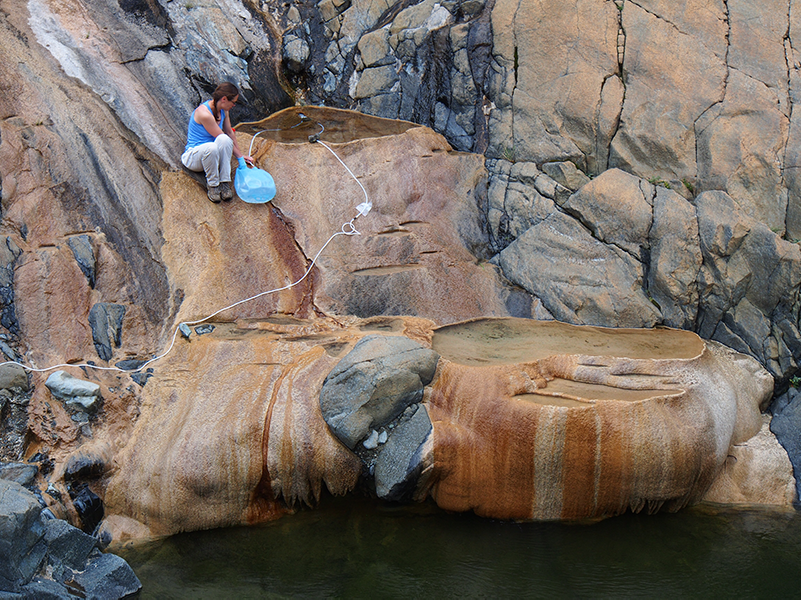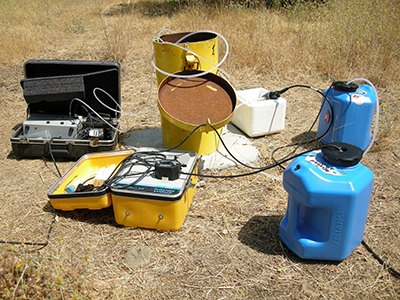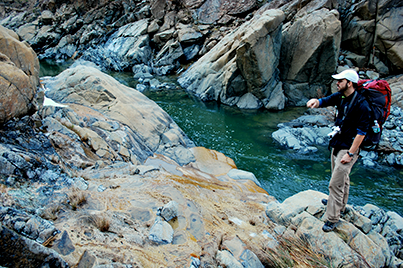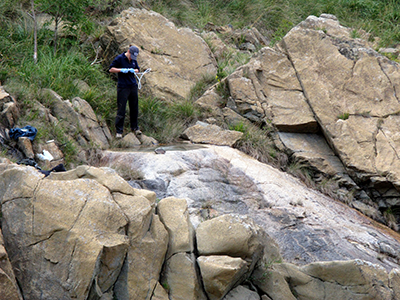
Serpentinization on Land
Serpentinization is the geochemical alteration of rocks that were originally formed in Earth’s mantle. When these mantle rocks are uplifted into the seafloor, hydrothermal systems, like the Lost City hydrothermal field, can be formed. When these mantle rocks are uplifted into continental crust (typically after they had been on the seafloor for millions of years), then products of serpentinization can be seen on land.
A review on the differences between serpentinization on land and in the sea, by Schrenk, Brazelton, and Lang. (2013).
We study serpentinization on land with two primary research strategies:
- Drilling into the rocks where serpentinization is occurring (or occurred in the past). Two examples are the Coast Range Ophiolite Microbial Observatory (CROMO) and the Oman Drilling Project.
- Exploring natural springs where the products of serpentinization are transported to the surface by groundwater. Two examples are the Tablelands and the Voltri Massif (see below).
Note that these are also the two basic strategies we have in the ocean: seafloor drilling projects and sampling natural seafloor springs like the Lost City chimneys.
CROMO

The Coast Range Ophiolite Microbial Observatory (CROMO) was established in 2011 with funds provided by the NASA Astrobiology Institute. Eight new boreholes were drilled with ultra-clean methods, including the use of purified water as the only drilling lubricant. Groundwater sampled from the boreholes has an extremely high pH (>12) and contains hydrogen and methane gas, signatures of serpentinization.
Research at CROMO has been led by Dawn Cardace, Tori Hoehler, Tom McCollom, and Matt Schrenk as the Principle Investigators and has involved many students and postdoctoral researchers.
The Brazelton and Schrenk labs have collaborated on the microbiological and metagenomic studies at CROMO:
- The first publication on the microbial diversity of CROMO groundwater, by Katrina Twing et al. (2017).
- Gene expression and metabolic activity in CROMO groundwater, by Melitza Crespo Medina et al., (2017).
- Metabolic pathways for carbon assimilation in CROMO groundwater, by Lauren Seyler et al., (2020).
- The sulfur cycle in CROMO groundwater, by Mary Sabuda et al., (2020).
- Flux and consumption of methane through the CROMO boreholes, by Mary Sabuda et al., (2021).
- Dispersal and selection of microbial communities in CROMO groundwater, by Lindsay Putman et al., (2021).
The Tablelands

Natural serpentinite springs can be seen at the Tablelands Ophiolite in Gros Morne National Park, Newfoundland, Canada. Ultramafic rocks of the Tablelands Ophiolite (also known as the Bay of Islands Ophiolite) were uplifted from the Iapetus Ocean and obducted onto the continental margin of Laurentia approximately 485 million years ago. Serpentinization remains evident today in the form of highly reducing, ultrabasic springs with extremely high pH (>12.5).
Research at the Tablelands has been led by Penny Morrill at the Memorial University of Newfoundland.
As a NASA Astrobiology postdoctoral fellow working with Matt Schrenk, I was involved in the early explorations of microbial diversity at the Tablelands:
- The first metagenomic study of serpentinite springs, featuring the Tablelands, by Brazelton et al. (2012)
- The first survey of microbial diversity in Tablelands springs, by Brazelton et al. (2013).
- The first geochemical analysis of Tablelands springs, by Natalie Szponar et al. (2013).
- The first metabolic activity experiments at the Tablelands, by Morrill et al. (2014).
After starting my lab at the University of Utah, Emily Dart and I conducted an experiment at the Tablelands with Penny Morrill to identify potential subsurface microbes. This was Emily’s undergraduate honors thesis, which is available as a preprint:
Dart et al. (bioRxiv preprint)
Penny Morrill’s team has continued to publish excellent work from the Tablelands:
- Kohl, L., Cumming, E., Cox, A., Rietze, A., Morrissey, L., Lang, S. Q., … & Morrill, P. L. (2016). Exploring the metabolic potential of microbial communities in ultra‐basic, reducing springs at The Cedars, CA, USA: experimental evidence of microbial methanogenesis and heterotrophic acetogenesis. Journal of Geophysical Research: Biogeosciences, 121(4), 1203-1220. HTML
- Morrissey, L. S., & Morrill, P. L. (2017). Flux of methane release and carbon dioxide sequestration at Winterhouse Canyon, Gros Morne, Newfoundland, Canada: a site of continental serpentinization. Canadian Journal of Earth Sciences, 54(3), 257-262. HTML
- Cumming, E. A., Rietze, A., Morrissey, L. S., Cook, M. C., Rhim, J. H., Ono, S., & Morrill, P. L. (2019). Potential sources of dissolved methane at the Tablelands, Gros Morne National Park, NL, CAN: A terrestrial site of serpentinization. Chemical Geology, 514, 42-53. HTML
- Cook, M. C., Blank, J. G., Suzuki, S., Nealson, K. H., & Morrill, P. L. (2021) Assessing Geochemical Bioenergetics and Microbial Metabolisms at Three Terrestrial Sites of Serpentinization: the Tablelands (NL, CAN), The Cedars (CA, USA), and Aqua de Ney (CA, USA). Journal of Geophysical Research: Biogeosciences, e2019JG005542. HTML
- Cook, M. C., Blank, J. G., Rietze, A., Suzuki, S., Nealson, K. H., & Morrill, P. L. (2021) A Geochemical Comparison of Three Terrestrial Sites of Serpentinization: The Tablelands, The Cedars, and Aqua de Ney. Journal of Geophysical Research: Biogeosciences, e2021JG006316.HTML
Voltri Massif

The Voltri Massif in northern Italy is a geological formation that was originally on the ocean floor 200 - 250 million years ago. It hosts natural springs (pH 11–12) that have an important role in the local Italian culture, where the extremely alkaline spring water is used for bathing and drinking. The springs were surveyed and catalogued by Italian scientists, including a key early study by Cipolli et al. (2003).
Gretchen Früh-Green of ETH-Zurich has led recent studies of the Voltri Massif springs, including the Ph.D. dissertation of Esther Schwarzenbach:
- Schwarzenbach, E. M., Früh-Green, G. L., Bernasconi, S. M., Alt, J. C., Shanks III, W. C., Gaggero, L., & Crispini, L. (2012). Sulfur geochemistry of peridotite-hosted hydrothermal systems: comparing the Ligurian ophiolites with oceanic serpentinites. Geochimica et Cosmochimica Acta, 91, 283-305. HTML
- Schwarzenbach, E. M., Früh-Green, G. L., Bernasconi, S. M., Alt, J. C., & Plas, A. (2013). Serpentinization and carbon sequestration: A study of two ancient peridotite-hosted hydrothermal systems. Chemical Geology, 351, 115-133. HTML
- Schwarzenbach, E. M., Lang, S. Q., Früh-Green, G. L., Lilley, M. D., Bernasconi, S. M., & Mehay, S. (2013). Sources and cycling of carbon in continental, serpentinite-hosted alkaline springs in the Voltri Massif, Italy. Lithos, 177, 226-244. HTML
- Alt, J. C., Schwarzenbach, E. M., Früh-Green, G. L., Shanks III, W. C., Bernasconi, S. M., Garrido, C. J., … & Marchesi, C. (2013). The role of serpentinites in cycling of carbon and sulfur: seafloor serpentinization and subduction metamorphism. Lithos, 178, 40-54. HTML
The Brazelton lab conducted the first survey of microbial diversity in the Voltri Massif springs, including metagenomic and laboratory investigations of metabolic activity. We showed that the pH 12 springs of the Voltri Massif are transporting distinct archaeal and bacterial communities, including methanogenic archaea and methanotrophic bacteria, from subsurface habitats where they are likely to be supported by hydrogen gas, methane, and possibly other products of serpentinization-associated reactions.
Publication: Brazelton et al. (2017) PeerJ
Associated Data: GitHub Repo